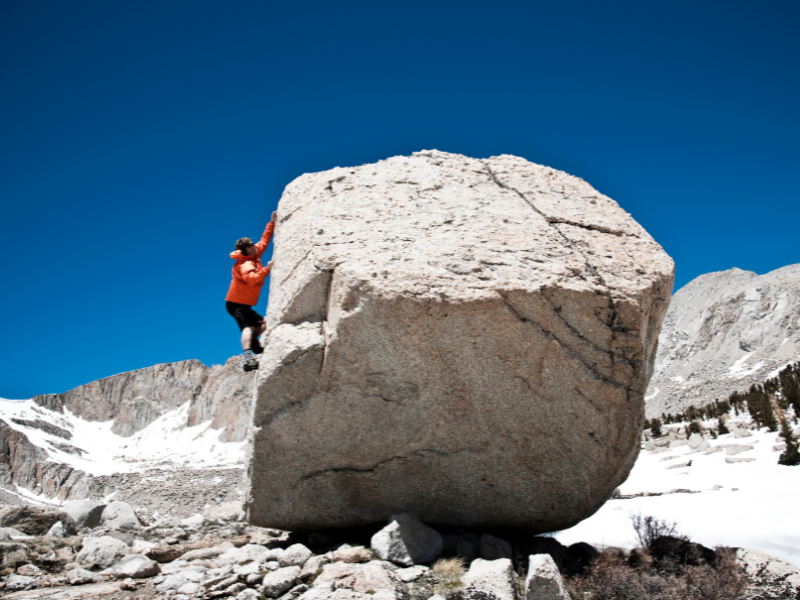Regardless of whether you ski or snowboard, after a few weeks of wear, your jacket's going to get stains and odors. After quite a few seasons of improperly cleaning my jackets and many jackets later, this is what you need to know about washing ski jackets.
You can and should wash ski and snowboard jackets. In general, most people wash theirs once during the season and once after. Besides removing odors and stains, there are performance benefits to washing your jacket, including; waterproofing, breathability, and increased longevity to your jacket.
Maybe this goes without saying, but unless you want to replace your ski or snowboard jacket prematurely, follow the manufacturer's care label instructions. But, contrary to popular belief, it's a good thing to wash your ski and snowboard jacket - here's why.
Why You Should Wash Your Ski or Snowboard Jacket
Let's start by discussing the elephant in the room - the smelly and stain-ridden elephant.
After a few days on the slopes, your jacket is going to stink. It doesn't matter how expensive it was or what brand it is.
Even if you're wearing an apres-ski puffy in the lodge, you're going to start stinking, and people are going to start giving you a side-eye. Especially in the lift line or when you get uncomfortably close to a stranger on the chairlift.
The same goes for stains. Ketchup, chili, or hot chocolate stains on your jacket look bad and are difficult to remove. The earlier you treat them, the better. But we'll touch on that later.
With the obvious odorous and slob-like reasons out of the way, there are three performance-related reasons to wash your ski and snowboard jacket.
1. Extend the Longevity of Your Ski Jacket
Without proper maintenance, technical outerwear of any kind loses its ability to perform to expectation. Jackets break down after continuous use, which deteriorates the fabric.
Washing your ski jacket removes the dirt, salt, oils, and other residues that contribute to this breakdown. In other words, it helps your jacket last longer.
Believe it or not, some people wear the same jacket year in and year out without ever washing it. And while they may look and smell the part, the real tragedy is that their coat isn't able to do its job. The jacket is the first line of defense from snow, wetness, and wind.
If compromised, each condition can create an uncomfortable experience at best and have serious health consequences at worst.
While once in the season, and once after the season are the general guidelines for washing your jacket, wash as needed. If you hit the slopes frequently during the season, consider once every few weeks.
Or after every new stain.
2. "Like-new" Water Resistance
Keeping your jacket as waterproof as possible is the foundation of any maintenance of a ski jacket. As your outer shell to the snowy world, this is critical to being able to take on the elements of the mountain.
Without adequate cleaning and care of your jacket, you'll lose water resistance and waterproofing features over time.
DWR (Durable Water Repellent) is a popular type of coating that's applied to nearly every type of water-graded outerwear.
Your ski jacket is your best friend on the slopes. It keeps you warm, dry, and protected from the elements. But after a few seasons of wear and tear, even the best jacket will start to lose its waterproofness.
This is because the coat collects oils, dirt, and stains that begin to clog and degrade the water repellency of the DWR (durable water repellent) coating.
If your ski jacket has aged, the waterproofness will also decrease. Think of it like your phone's battery - out of the box, it will last without a new charge for days.
But a year later, once you take it off the charge, you have 6 hours at best. here's a shelf-life to the repellency of your coat similarly, where after so much use and wash cycles over years, you may have to get a new ski jacket. There are some after-market alternatives for this as well, but in general, the most effective fix is a new jacket.
So be good to your jacket, and help it keep its mojo for another season.
3. Breathe In, Breathe Out
If you ski or snowboard, you know that keeping warm isn't always the goal. Keeping at a comfortable temperature that is flexible to your body's temperature is the real aim.
The breathability of your jacket and outerwear is one of the biggest reasons you can stay at a comfortable temp.
And when you don't regularly or properly wash your jacket, you're compromising how breathable your jacket can truly be. And over time, it can get to a point beyond repair if not regularly maintained.
The best way to think of how breathability works in your ski or snowboard jacket is to think of your face. Your pores, when functioning properly, help moisturize your skin. But when they are clogged, they can't do this properly.
Your jacket is covered with millions of pores per square inch, and these allow air to move through membranes and provide breathability.
Just like a clogged pore on your face, if blocked on your jacket, you lose breathability - and your jacket can quickly get covered in oils and dirt after just a few uses.
If that happens, there goes your airflow - making it easier for you to overheat, or get chilly.
Taking Care of Your Snow Jacket
Anyone who's ever been on a ski trip knows the importance of a good ski jacket. A ski jacket needs to be waterproof, windproof, and warm - three things that are often at odds with each other.
As a result, there are a variety of different materials and construction techniques that are used in ski jackets, each with its strengths and weaknesses.
- Synthetic fabrics are excellent at repelling water, but they can often be bulky and not as breathable as other materials.
- GORE-TEX membranes are great at keeping out moisture, but they can be expensive and can make a jacket feel stiff.
- Down jackets are incredibly warm, but they lose their insulation if they get wet.
As a result, it's important to choose the right ski jacket for your needs - and to know how to care for it properly. With a little care, your ski jacket will keep you warm and dry all season long.
If you're looking for a more general idea of how to take care of your jacket, keep reading. And believe me, you're not alone. It's a common question that customers ask in our store.
And one more item before we get to it - if you're thinking of skiing or snowboarding in a "normal" coat - just don't. If you need further convincing on why you should wear a normal coat skiing, I'll leave this for you here.
Ski and snowboard jackets can get pricey - in fact, the shell layer is typically the most expensive layer of clothing for winter sports.
Taking care of this investment will save you money long-term, that is unless you like to buy a ski jacket every year.
How to Wash Your Winter Sports Jacket
In general, there are four steps that you can apply to wash just about any ski and snowboarding jacket - just remember to read your care label first though.
1. Prepare the Jacket for Cleaning
Before starting the cleaning process, do a quick check throughout. Empty pockets of lip balm and tissues. Check the zippers on your pockets and that your vents are closed. Button the snaps down. Seal the velcro.
You want every sort of trim piece to the jacket to be secured. This is going to reduce the wear on critical parts of your jacket that make it functional, a la zipper pulls and buttons.
And nobody wants lip balm coating their coat - that's a quick way to buy a new jacket.
After you batten down the hatches, turn your coat inside out.
This will further prevent any potential damage during the wash cycle - the usual victim here is a broken zipper.
Which by the way is a pain to repair, and one of those items you think you can go skiing with while it's broken, then quickly realize how important a functioning jacket zipper is.
Nearly all manufacturers recommend the items in this step - if yours has different instructions, you'll find it on the care label.
2. It's Time to Machine Wash
First things first, there's a myth that's been circulating for years that you can't machine wash your ski or snowboard jackets. It's just completely untrue for the majority of jackets. For the record, you can machine wash your ski jackets.
One you might avoid would be down, because the feathers can easily clump during a wash and even mold, but it's still an option as well.
Now, there is one true exception to machine washing your ski jacket, but it isn't so much about the jacket, or even the fabrics and fibers. It's the washing machine's fault.
I'm specifically referencing top-loading washing machines with agitators - most manufacturers recommend avoiding them.
With an agitator, your jacket has the potential to wrap itself around the device and can lead to rips and stretched fabric.
Agitator aside, your care label will tell you a temperature to use, but it will be either cold or a warm cycle. Avoid hot water, this will mess up any sort of DWR on your jacket, to a level beyond repair.
And you'll have to get a new jacket as result. In which case I'll direct you to the Obermeyer Charger jacket. Which is made of REPREVE, the 100% recycled fabric that turns plastic water bottles into fabrics.
But back to your jacket and how to machine wash it. In short - choose the correct wash cycle, prescriptive to the care label inside your jacket.
3. Be Picky About Detergent
This step is going to take you down a completely different path depending on what jacket you have and the fabric it's made from.
On the care label, your manufacturer will recommend a specific laundry detergent best suited for the coat’s materials. The recommendation isn't made to be snobby either, it's there to increase the lifespan of the all-important DWR coating.
The type of coat you have will determine which specific detergent will need. For instance, if your coat’s insulation is down, you want to use a down-specific soap. The same would apply to synthetic insulation.
Right before you start the cycle, double-check for any remnants in the dispensing area of your washing machine - the little drawers for detergent and fabric softener. Any residue can lead to a diminished quality of your jacket.
If you find any sort of leftovers, remove your jacket, wipe out the dispensing drawer, and do a quick cycle with hot water to clear it. Then it's showtime.
4. Drying - It's Complicated
Drying is the last stage, but also the one with many opinions and recommendations. From personal experience, I air dry nearly all outer layers (pants included), regardless of the manufacturer's advice.
Across manufacturers, and even jackets within the same manufacturer you'll find a wide range of recommendations. Some recommend air drying after the wash cycle, while others recommend putting the jacket in your dryer on a medium to low heat.
If you have a down-insulated jacket, use a few tennis balls or wool balls, and set the heat to low - don't leave it in for too long though. Check every 15 to 20 minutes.
The tennis/wool balls will help evenly disperse the feathers, giving it a better fluff.
Similarly, if you have synthetic insulation in your coat or a regular shell jacket, if you decide to not air dry, use a low-heat cycle for no more than 20-minutes.
Again, these are general recommendations for drying your ski or snowboard jacket; always read the label on your jacket for the best instructions.
So why do I always air dry? There are too many things that can go wrong with machine drying a technical jacket. It's not so much that the jacket is to blame, it's more so that every dryer is different, and caring for buttons, zippers, velcro, tumbling, temperatures, dryer jargon, etc.
It all adds up to be too many variables that can go wrong, and ruin a perfectly good jacket that had a mustard stain on the lapel.
Since switching to air drying my outer layers, I've never had an issue. Additionally, if you go the natural way on drying, take your jacket outside to dry - it speeds the process up significantly.
Don't forget to store your jacket correctly for the off-season, once it's dry. This will prevent creases or any sort of harm to the technical components. A good old-fashioned hanger will do the trick. You can always add a storage bag to cover any sort of sun damage - but if your closet is getting sunlight, is it even a closet?
Yes, You Can and Should Wash Your Ski Jacket
Anyone who's ever bought a brand new ski or snowboard jacket knows the proud and confident feeling you get when you wear it down your first run.
You can't wait to hit the slopes in your new coat - but in order to make sure that your jacket lasts, it's important to take care of it.
If you don't wash your jacket properly, you risk the chance of needing to purchase a new ski or snowboard jacket sooner than you'd like.
It's the whole "take care of your belongings and they'll take care of you" philosophy at play.
That means washing it regularly, and not just throwing it in the washing machine on a hot cycle.
Over time, all the dirt, grime, and sweat that your jacket picks up will break down the fabric and cause it to lose its waterproofing. And it will lose its ability to retain heat or maintain a comfortable temperature.
So how do you wash a ski or snowboard jacket? While there are four general steps to washing just about any coat, there are nuances per manufacturer, coat style, fabrics, and fibers - so always read the care instructions for your jacket.
By taking these steps, you can help ensure that your ski or snowboard jacket remains in good condition for years to come.



